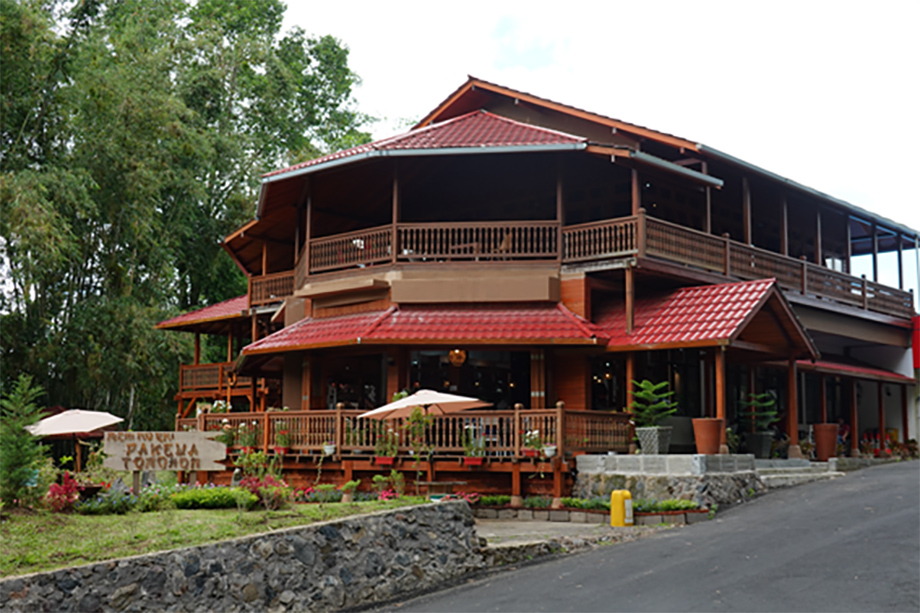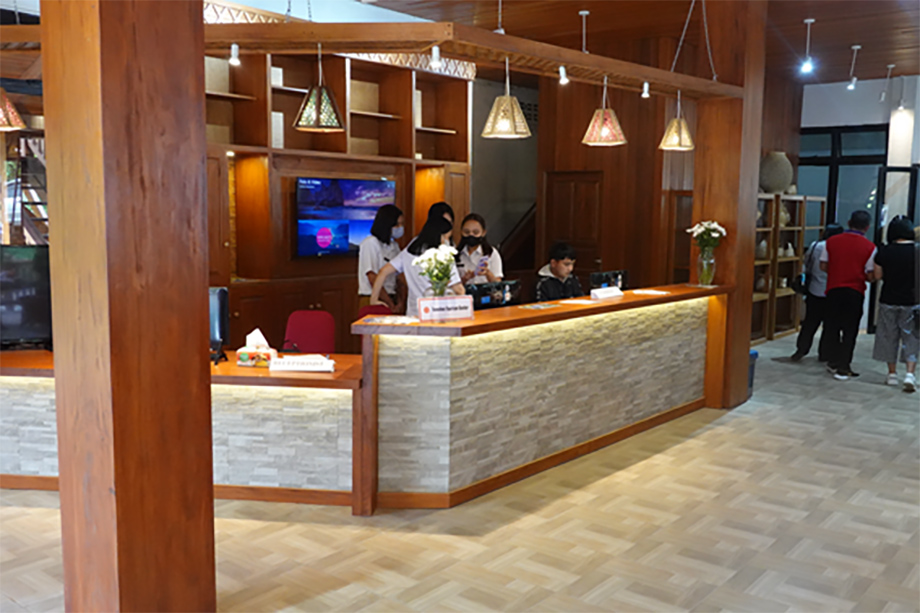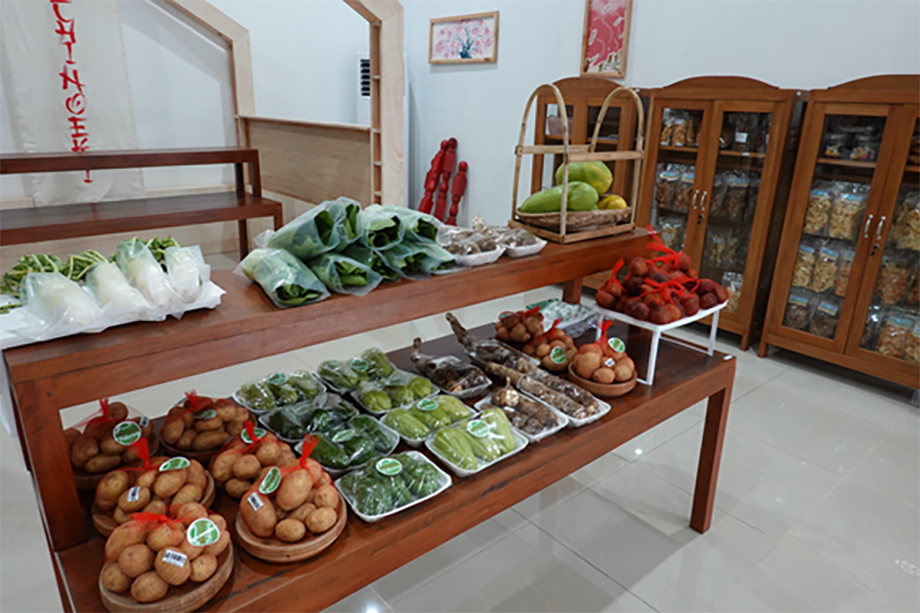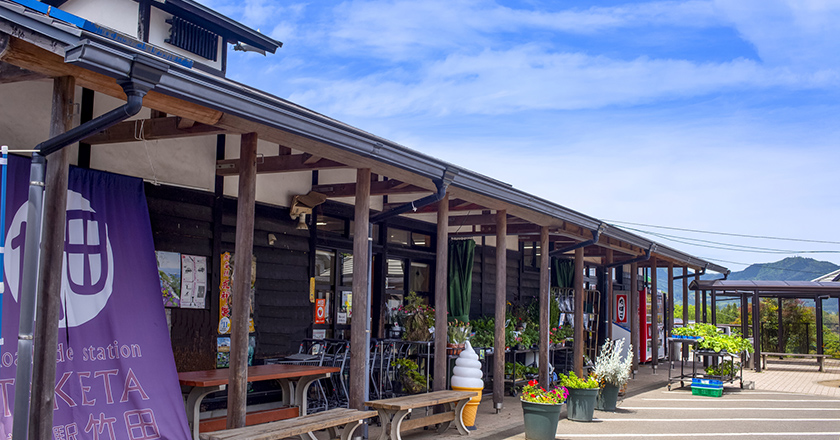The basic concept of Roadside Stations is a unique and lively place created together with local communities
Roadside Stations along the roads in different parts of Japan are publicly established and privately operated facilities, certified by the Ministry of Land, Infrastructure, Transport and Tourism (MLIT). They are mainly established by the municipalities and are operated by the designated administrators such as joint public-private ventures, Japan Agricultural Cooperatives (JA), and local companies. Their basic concept is a unique and lively place created together with local communities. They have three basic functions, including rest function consisting of parking spaces and restrooms that are available 24 hours for free, an information transmission function related to roads, sightseeing, disaster prevention, etc., and regional coordination function to encourage exchange and partnership between regions, or regions and visitors via regional promotion facilities equipped with cultural sharing facilities, and tourism and recreational facilities.
Moreover, what are most popular now at many Roadside Stations are farm stands and specialty goods sales stores that sell local farm products and specialty goods. Furthermore, thanks to these economic functions, including restaurants serving local product dishes, hot spring facilities, and accommodations, an increasing number of local governments want to establish Roadside Stations. Since the establishment of the system in 1993, the number of Roadside Stations has increased rapidly and reached 1,213 as of 2024. Roadside Stations became the driving force for regional revitalization as hub facilities for both the proclamation of a tourism-oriented country policy, of which the action program started in 2014, and the regional revitalization policy which started in 2015.
The idea of Roadside Station originated at the symposium held in January 1990 in Hiroshima, organized by the Chugoku Region Local Community Development Association. It was one of the meetings that were held in different places to promote measures for revitalization led by local residents, based on the concept of “endogenous development theory,” in which the people who live there know best about the local issues. At the meeting, Mr. Kazuaki Sakamoto, the then representative of Funakata Farm Group in Yamaguchi Prefecture, stated: “Just as there are stations on the railways, there should be also stations on the roads.” Mr. Sakamoto, having a very relaxed personality, shared his experience of having struggled with looking for a restroom on the way to the venue. This anecdote warmed up the meeting. From there, the discussion advanced, and in 1992, social experiments started. In 1993, the registration and guidance system for the Roadside Station was established. One hundred and three stations were registered in the first year of the system.
In the beginning, they just displayed a Roadside Station sign at the space with a parking area and restrooms. The local residents reacted positively to this project. They thought, “If people passing by the road are willing to stop by, why not place local farm products and specialty goods there?” With this idea they started their activities. Gradually, Roadside Stations changed from mere resting facilities with restrooms and parking spaces for drivers, to facilities that users can enjoy, where each station expresses its regional characteristics and uniqueness, and provides tourism information and holds various events.
Disaster prevention, medical and welfare services in addition to rest, information transmission, and regional coordination functions
Each Roadside Station is set up and operated with its unique concept applying its local characteristics. Through the ingenuity of the management, Roadside Stations aim to increase the number of people visiting from outside the region by promoting local industries and revitalizing local communities. In recent years, their public functions, such as disaster prevention, medical and welfare services, and resident services, have been enhanced. They are becoming a hub for autonomous transportation (MaaS: Mobility as a Service) to help people with shopping difficulties in depopulated areas.
People started to pay attention to the disaster prevention function of Roadside Stations after the Mid Niigata Prefecture Earthquake in 2004. The afflicted people gathered at the Roadside Station voluntarily without being instructed by anyone. In some Roadside Stations in the afflicted area, while telephones and other means of communication were not functioning, the afflicted people used the facility’s wall as a message board to confirm each other’s safety and communicate with one another. In the outer garden of the stations, soup kitchens were held, and relief supplies were distributed. It is said that officials of the MLIT, which originally established this system, were rather surprised to see this. After that, Roadside Stations started to attract attention as a disaster prevention hub, and this function was enhanced in various places.
During the 2011 Great East Japan Earthquake, the topic of “Nookairin Road 6,” where six Roadside Stations in Miyagi Prefecture became a reconstruction base, was widely taken up by the media, etc. Under the circumstances in which relief supplies from outside areas could not reach the area because roads were blocked by the disaster, the six stations shared food and emergency supplies with each other and contributed to the reconstruction.
Their capability to compensate and cooperate with one another is the advantage of Roadside Stations. Eight Roadside Stations located in Minamiboso City, Chiba Prefecture, share disaster prevention functions, farm products, and tourism functions with each other, and organize the network of eight stations to fulfill major functions. In 2020, these eight stations were each selected as a Priority Roadside Station and represent the exemplar Roadside Stations that the MLIT prioritizes its support for. In recent years, the Roadside Stations networks have been drawing attention nationwide. Toono 10 Stations Network in Gifu Prefecture is also making considerable achievements to resolve local issues. It is expected that the trend of mutual Roadside Stations networks sharing their functions will continue to increase.
While the number of community halls nationwide has decreased by about 30% from the peak time owing to the accelerating rural population decline in recent years, so far only four Roadside Stations have had to close because of a low number of customers and an increased deficit. Unlike unprofitable public facilities that were once called “Hakomono,” Michi no Eki is based on the fact that it is independently profitable, and the fact that the stations themselves are profitable entities has led to their sustainability. In order for a Roadside Station to be a lively place in the community, which is the original concept, it can be said that their public nature and public benefit are very important. Private tourism and commercial facilities that emphasize production efficiency tend to be profit-oriented and not suitable as a hub to revitalize hilly and mountainous areas with declining and aging populations. However, if the revenue of a Roadside Station is always in the red, and the loss must be made up by the tax of the local government, it cannot be the engine of economic revitalization. In order for Roadside Stations to function well for regional revitalization, it is essential that they try to produce and distribute goods and services by using local employment, production methods, and local materials, and enhance intra-regional economic circulation, which can attract consumers from outside the area as well as within the area. Moreover, publicly beneficial functions such as disaster prevention and resident services do not necessarily lead to increases in public funding such as tax money. According to my study results so far, there are econometric analysis results showing that Roadside Stations which focused more on disaster prevention functions such as those of a supply warehouse, common square, and communication facilities were more successful in increasing visitors and sales. By setting up a branch office of a city hall and providing resident services such as issuing residence certificates, increases in shopping customers can also be expected. In order for Roadside Stations to develop sustainably in the future, it is considered that the evolution and changes according to the times are important.
Globally expanding Roadside Stations may have more possibilities by advancing DX
The system of Roadside Stations functioning as local hubs is exported abroad, and started to be recognized internationally as Michi-no-Eki. “Aren’t Roadside Stations, where local people gather and build face-to-face relationships, a wonderful system that can help local disaster prevention and crime prevention in developing countries?” This is what former United Nations staff member Ms. Kazuko Kano thought. To the U.N., she introduced Mr. Fumio Kato, who was the general manager of the planning department of Minamiboso City, and was a key player of the Minamiboso City 8 Stations network. Then, as a Japan International Cooperation Agency (JICA) project, Mr. Kato instructed on how to establish Roadside Stations. Until now, Roadside Stations have been established in nine developing countries, including Indonesia, Thailand, and Malaysia, through Official Development Assistance (ODA).
See New Roadside Station opened in the city of flowers near Manado, the second Japanese-style station in Indonesia, in cooperation with Minamiboso City. JICA
https://www.jica.go.jp/overseas/indonesia/information/press/2023/20230607.html



Concerning Roadside Stations that were established abroad so far, some were built entirely as a public facility, while others integrated the functions of Roadside Stations into something like the local shopping association. Thus, how they were accommodated varies among countries. However, the concept of them being local hubs where people come together is the same as in Japan. The feature of selling locally harvested farm products, etc., is also the same as in Japan. They are used as a hub for regional crime prevention, disaster prevention, and tourism promotion in developing countries to help revitalize their economies, and the project continues even after the completion of the JICA project. Roadside Stations have effective potential to respond to various societal issues that are in disarray. Roadside Stations will continue to develop as a hub to bring liveliness and peace where people can gather, not only in Japan but also worldwide.
Even during the COVID-19 crisis, Roadside Stations were the only tourist attraction that could maintain social distancing, and the number of visitors did not dramatically decrease, unlike general private tourist facilities. Furthermore, nowadays, owing to the progress of the new normal after the COVID-19 crisis, more people are moving to the countryside or living in dual locations. Some Roadside Stations started to organize their facilities as a base for workcation or a base to help people who want to start businesses in rural areas by advancing DX of Roadside Stations.
Shrinking local populations will decrease local tax incomes and will lead to the deterioration of government services such as education, medical care, and welfare, as well as local transportation, and local community functions. As a result, more people will flow out to urban areas, looking for better education, medical and welfare services, and convenience of life. By using a Roadside Station as a hub, if people everywhere in Japan can receive the same quality of public services as urban areas, such as education, medical care and welfare, and transportation and community, the outflow and concentration of the population in urban areas will be eliminated. The Roadside Station is a system that can adjust to different local community situations. It has the potential to serve as a base for people to continue living in the region in which they were born and grew up. The global situation is full of confusion such as the COVID-19 crisis, the Russian invasion of Ukraine, and the conflict between Israel and Hamas. I believe that Roadside Stations, which can evolve and change in accordance with the changing times, will increasingly develop as a system that plays a very important role in the revitalization of the region at this time, which is said to be a turning point.
* The information contained herein is current as of March 2024.
* The content of articles on Meiji.net are based on the personal ideas and opinions of the author and do not indicate the official opinion of Meiji University.
* I work to achieve SDGs related to the educational and research themes that I am currently engaged in.
Information noted in the articles and videos, such as positions and affiliations, are current at the time of production.

